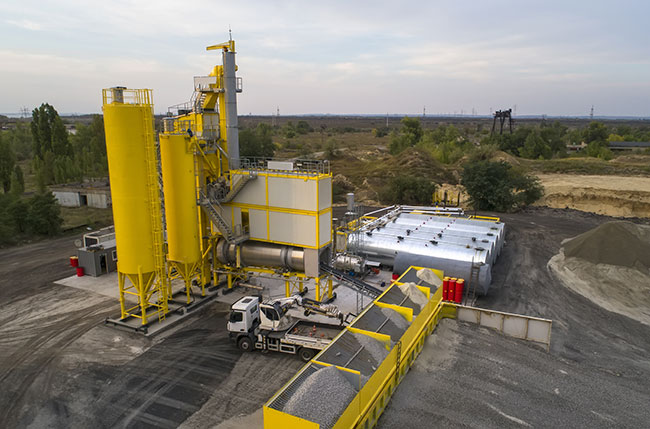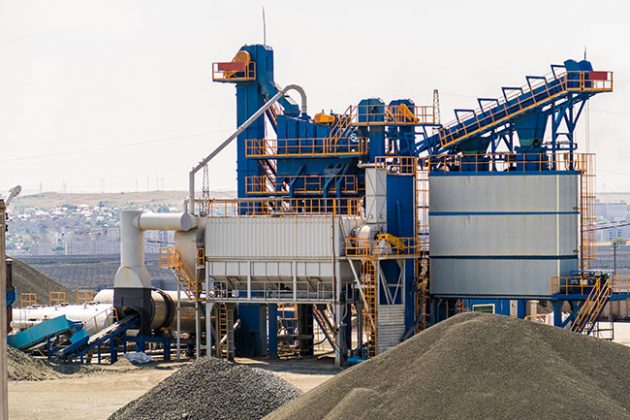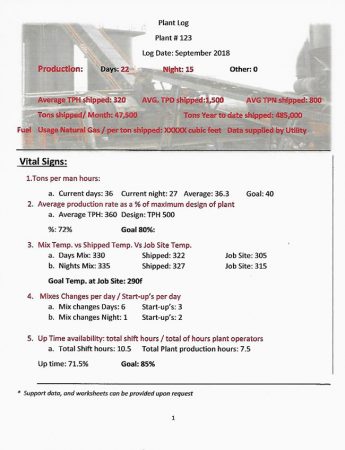
Features
Columns
A log-based platform: A way forward
Hot mix asphalt plants Part III: A log-based platform
May 5, 2020 By Ken Monlux

This is part three in our discussion of plant reporting and documentation.
In the first article (“Baseball and hot mix asphalt plants” in the November/December 2019 issue), I introduced the log-based platform.
In part two, we take a deeper dive into the core of The Log. In this article, we will look at the steps needed in order to provide The Log to your plant sites.
Let’s suppose you are ready to either install or to transition to a log-based platform. Let’s take a look at what’s involved.
What option would work best for your company?
- A log-based subscription service provided by an outside contractor. The subscription service would provide all aspects of the platform;
- A fully designed log-based platform created by a contractor on behalf of the plant, then managed internally. The position of log editor would be an in-house employee with access to outside training and support; or
- A modified log-based platform using current in-house data collection and managed internally. An outside contractor would manage the transition phase. As with the second option, the position of log editor is filled by an in-house employee.
The log editor
The position of log editor is significant to the success of the program. The editor must have deep knowledge of the hot mix process. They must have attention to detail and be diligent in their work effort. They require the ability to work with various platforms via the Internet and other methods of data collection. The right log editor will make or break The Log. Let’s look at the steps:
- The pre-setup meeting
This meeting needs to be presented by the development team of the log-based platform to provide answers and direction to the project. There are two management levels that would benefit from this initial presentation.
A. The executive managerial group will be provided with an overview of the process and framework of the steps needed to be installed at the plant site.
The development team will:
i. Establish a projected timeline;
ii. Request access to various resources to establish The Log; and
iii. Request a “point of contact” from corporate that would be assigned as a liaison.
B. The local manager will be provided with a presentation by the development team, which will attempt to provide insight into The Log. This can be done as a single presentation to all the local managers, or as part of the site visit.
The development team will:
i. Provide a full explanation of The Log and time for questions; and
ii. Invite the local manager to join the development team.

The editor must have deep knowledge of the hot mix process. They must have attention to
detail and be diligent in their work effort. They require the ability to work with various
platforms via the Internet and other methods of data collection. Photo: iStock.
The site visit
Before the site visit, it may be helpful to get a view of the plant site via Google Earth. It’s amazing what you can discover by taking the time to study this photo. Such things as stockpile management, housekeeping, and truck routes are but a few. So, even prior to arriving on site, the development team would have a general idea of the operation.
The site visit is paramount to the success of the program. The site visit is part interview, part data collection, and part plant site inspection. The site visit would be conducted over a single day, preferably during a production run.
The objective of the site visit would be to get a feel for the layout of the plant and the personalities of the crew. The team would start to develop a relationship and line of communication with the local management. In addition, it would allow the local manager to better understand the roll of the editor. Armed with a successful site visit, the development team walks away with the needed knowledge of the day-to-day flow:
Listen to the manager:
- How does he view the plant?
- What are his priorities?
- What changes would he make?
Inventory:
- Stockpiles of aggregates, RAP, and tank storage;
- Flow of production process; and
- Silo storage: number and configuration.
- Typical times of operation: days per week, hours per day, and/or per night.
Crew jobs description:
- Observe the interaction within the crew;
- Response of the crew to such things as hours of operation, breakdowns, and night work;
- Interview of quality control technician assigned to plant; and
- Interview with sales/service assigned to plant.
Perform a Data inventory:
- List all forms of data generation at the site;
- Start to formulate site-specific forms, and vital signs; and
- Take note of current data recording, dashboards and other methods of documentation on site.
3. Design of the log-based platform
Based on the site visit, a recap report is written. This recap is generated from notes, interviews, and questionnaires collected during the site visit. This document is distributed to the local manager and point of contact for comment and corrections. Once corrections are made, the recap will become the foundation of The Log.
Development team starts to:
- Design the plant report form;
- Establish vital signs;
- Contact utility company (in the case of smart meters); and
- Work with point of contact who can provide additional statistics:
- Q.C. reports
- Inventory control
- Summary of truck tags
The design phase goes on until all parties are satisfied and agree that The Log will meet the needs of the plant. Once done, the team starts to look at the remainder of raw data sources in an effort to integrate with The Log. This step is to develop the balance of the Log’s narrative. Once reviewed and approved, a mock-up of the Log will be produced. The purpose of the mock-up is two-fold: a training tool for the editor and educational device for the local manager.
In an effort to be brief, we will only look at page one of the Log in mock-up form. The other portions will be provided in summary only:

By design, this mock-up provides a lot of information that can be absorbed quickly. Image: Ken Monlux.
Mock-up
Let’s take a moment to examine the mock-up on the right of the page.
By design, it provides a lot of information that can be absorbed quickly.
The top of the page is laid out to give the manager a summary information of the production. This information is formatted in such a way as to provide a framework of the outcomes of the vital signs. It establishes where the plant is at that point in time.
Moving down the page, we are directed to the vital signs.
Set in no particular order, the vital signs indicate the health of the plant. It is interesting to remember that the vital signs do not find fault. Their function is to make the data understandable; make the data relevant; and challenge the manager.
Of the three, the “challenge” may need a little more discussion.
By identifying areas where a goal is not met, the manager can start to look for ways of improvement.
For example, looking at the mix temperature, the manager would work with the plant operator in an attempt to get closer to the desired job site mix temperature goal.
From time to time, the editor may elect to exchange a satisfied vital sign for a new and different sign.
In this way, The Log continues to challenge the local manager.
The balance of The Log platform can be easily summarized by sections and appendixes as follows:
- Narrative overview from the plant performance;
- Recap of conversations between the editor and the manager;
- Day-to-day summary of weather;
- Appendix I: Daily Shift Plant Report: an electronic copy of the plant reports/date;
- Appendix II: Inventory;
- Appendix III: List of in-house or outside major projects supplied;
- Appendix IV: QC spreadsheet: Based on data supplied by in-house QC department.
The Log-based platform, as delivered to the local manager, makes good in its commitment to provide a simple to read, easy to understand document.
The Log also works well as an archived testimony of the operational performance. Once digested, it can be filed and retrieved as needed at some future date.
So, we performed our site visit, developed site-specific forms and spreadsheets integrating various platforms and reports. We then produce a mock-up of what the Log should look like. It’s time to put all this effort into practice. Prior to going online with all sites, we will perform a trial run at a single site. We will be looking for:
- How well the data collected, forms and other platforms are combined to provide the desired outcome;
- Verify that the editor will be able to perform and deliver The Log in a timely manner; and
- Use the beta site as a training tool for the in-house editor.
CONCLUSION
Let’s look back.
In Part One, we looked at the lesson provided by MLB baseball in the area of statistical evaluation. In an effort to make their team better, baseball went away from traditional reporting.
We started to define what is meant by a “log-based documentation” platform and how it differs from traditional production reports currently being used.
In Part Two, we took a deeper look at what is at the core of The Log. We learned what Vital Signs are, and how best to use them.
By adding the evaluation step, we are able to support the manager’s ability to quickly digest the data. The Log is formatted to provide an advantage in having a straightforward technique to reconstruct any given day.
What is the takeaway from a log-based documentation platform?
- It is site-specific, interactive and directed at local management;
- It quickly and effortlessly provides a distilled version of the health of the plant;
- It challenges the manager towards positive improvement;
- It adds the extra step of evaluation of data, looking for trends;
- It is an archive of operational performance that can be referred to at any time.
So once again, ask yourself, are you content with your current production reporting? Are you pleased how your current reporting is used to improve the overall operation?
If you answered “no” to either question, why not consider the log-based platform?
If you have any questions, or comments please feel free to contact me at: kenmonlux@yahoo.com.
 Ken Monlux is a consultant, who specialized in operational management issues. With over 30 years’ experience in hot mix plant operations, ready mix concrete operations and environmental clean-up and permitting.
Ken Monlux is a consultant, who specialized in operational management issues. With over 30 years’ experience in hot mix plant operations, ready mix concrete operations and environmental clean-up and permitting.
Print this page